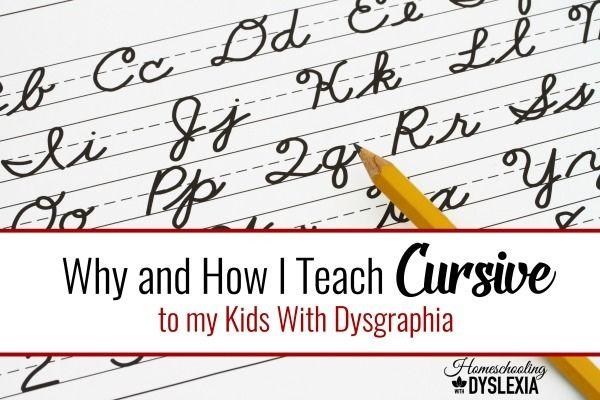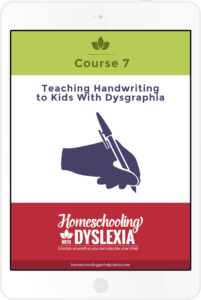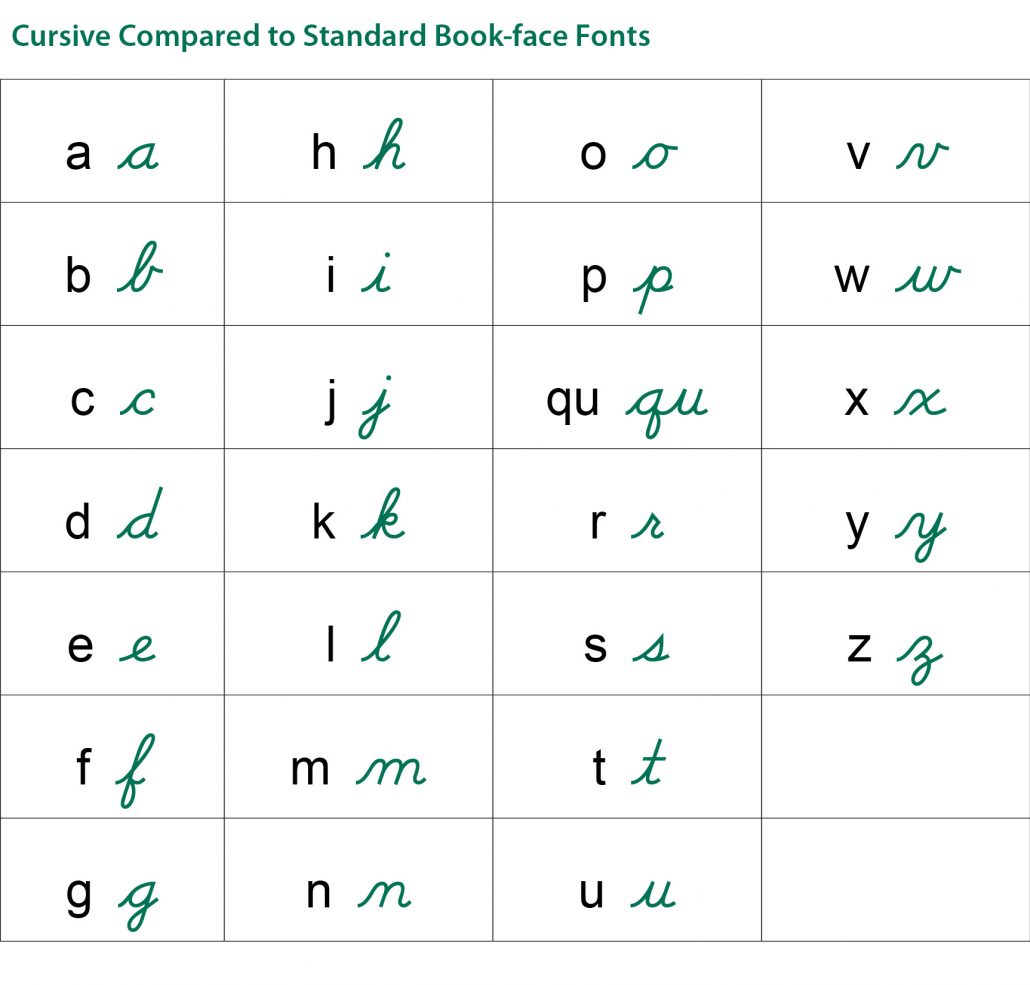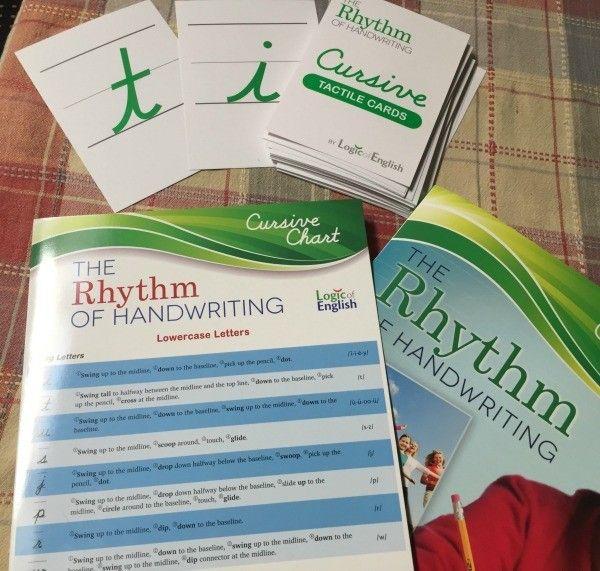
It took some time for the dust to settle after our eldest’s dyslexia diagnosis. Not even knowing that dyslexia existed, we had a huge learning curve. It wasn’t long before we began to understand that many dyslexics also struggle with handwriting – also known as dysgraphia.
To learn the signs of dysgraphia – read this.
As with dyslexia, we tried many different approaches to teaching handwriting (with many different levels of success) from no handwriting at all in the early years to no cursive and now to cursive as soon as possible.
Why I Teach Cursive to My Kids With Dysgraphia
Cursive has six main advantages over printing:
Cursive is less fine-motor intensive.
With cursive the pencil is lifted only between words and requires less fine-motor movement. With printing, the pencil must be picked up between letters creating more up and down motion and therefore more fine-motor movement.
Try it yourself. Take a minute to write the word ‘reading’ in print and cursive. Cursive is actually less demanding on the hand than printing. This is because cursive was designed for the human hand whereas printing was designed for the printing press.
All the lowercase letters begin in the same place on the baseline.
Printed lowercase letters begin in seven different places. Some begin on the baseline, others at the top line, other at the midline. This creates confusion for beginning writers about where to place the pencil. If you have kids with dysgraphia, you know what I’m talking about here! In addition this decision must be made again and again within a word. In contrast, this issue is solved with cursive; all the lowercase letters begin on the baseline. Students always know where to begin a word.
Spacing within and between words is controlled.
When printing, it is common for students to put too little space between words and too much space between letters within a word. By teaching cursive, these problems are easily resolved as students feel the motion of picking up their pencil between words (emphasizing the beginning and end of each word) and feel the connectedness of the letters within words (emphasizing how these phonograms are blended into one word).
By lifting the pencil between words, the beginning and ending of words is emphasized.
Many students also struggle with knowing where words begin and end while reading. They will blend the final sounds of one word with the initial sounds of the next word, thereby demonstrating a confusion about the role of spaces in printed texts. Again, since the pen or pencil is only lifted at the end of words when writing in cursive, this problem is eliminated.
It is difficult to reverse letters such as b’s and d’s.
Many students who begin by learning to print frequently reverse b’s and d’s and p’s and q’s in both reading and writing. This is due to their similarity in shape and the students’ lack of clarity about how to form the letters. Cursive handwriting makes letter reversals more difficult and helps to minimize this type of confusion. Notice the distinctions between a cursive b and d and the p and q. When students learn cursive first as well as clear directions for letter formation, reversals are minimized.
Won’t Cursive be Confusing?
One of the reasons that I resisted teaching cursive handwriting early to my kids was that I thought they would be confused and have difficulty reading the printed fonts in their readers and printed books. However, a quick look through the following chart shows that most cursive letters closely resemble their printed partners.
How I Teach Cursive First
After researching and studying to present my Parent Class on Teaching Writing to Kids With Dysgraphia parent course, I learned that this neurologically-based learning issue can be caused by difficulties in sequencing, poor working memory and weak fine motor skills. Logic of English addresses each of these weaknesses in their simple-to-use, straight forward writing program – The Rhythm of Handwriting.
Benefits to The Rhythm of Handwriting
- Students learn letters with a multi-sensory approach that begins with large-motor movements.
- Instructions emphasize the rhythmic motions needed to develop fluid handwriting.
- Letters are grouped by initial strokes in order to simplify the learning process and encourage the development of muscle memory.
- Each lesson includes a variety of line sizes so that students can use whichever size is most comfortable for their hands.
- Logic of English has developed a unique font that is designed to require a minimal amount of fine motor skill, with attention to developing rhythmic handwriting.
Learn More
For more information on teaching kids with dysgraphia:
How I Teach Handwriting to my Kids With Dysgraphia: Preschool to High School
Parent Class: Teaching Writing to Kids With Dysgraphia
 This class takes an in depth look at:
This class takes an in depth look at:
- what dysgraphia is,
- how it affects learning,
- how to modify instruction for kids with dysgraphia
- how to remediate dysgraphia, including:
- ways to enhance visual perception,
- ways to strengthen gross motor skills and motor planning skills
- how to strengthen fine motor skills
- how to strengthen working memory, and
- how to teach kids to organize their writing
- how to implement the best accommodations for kids with dysgraphia
- an extensive list of resources for teaching kids with dysgraphia








Didn’t you use Handwriting Without Tears in the past? If you did, can you share what HWT is missing? I see the pros of this current program.
Hi Lisa,
I have never used HWT but haven’t met anyone who doesn’t like it!
Do you know how this program differs from HWT? I’m not familiar with either program but have 2 children with dyslexia and dysgraphia, therefore I’m looking for something that will be suitable for them.
I Like HWT as an Educational Therapist for Students who are taught print first. However, many admin who do not understand the neurological benefits to Cursive like to see more of a slant and choose other handwriting programs. I like HWT only because of the legibility and similarity to print if a student learns that first. Otherwise if they are taught Danielan (Sp?) then I think either would be fine. I like the consistency. I do use Rhythmic Writing in my practice. It has huge benefits for students with dyslexia and dysgraphia.
My DD is 8 she most definitely has disgraphia. She went to PT for fine motor support last summer but I saw little improvement and they had no interest in accommodating after school appointments. When I contacted the school at Christmas concerned about seeing little improvement in her handwriting I wanted cursive. They wanted to give her a keyboard. I agreed to their plan. She is a very artist girl. She has drawing skills that rival some of my better middle school student. I feel that cursive would be more interesting to her than the other two options. She actually loves to story tell. If you ask her to write something for you then she’ll likely produce 6 pages of unreadable text. I’m going back to cursive after reading your article.
My child is the same but he is nearly 12 and has developed his own mixed font..he was forced to print for 5 years of school so many of those letters are entrenched in his mind. He did remediation with magic link cursive…
Thanks for sharing about cursive & dysgraphia — I’m compiling a list of links to share why cursive is still useful! I love the part: “cursive was designed for the human hand whereas printing was designed for the printing press”.
When you taught cursive, did your student get confused with going to script? My son is 7 going on 8, was assessed for dyslexia but did not qualify..but he does have reading challenges and reverses his letters. So I am thinking of teaching cursive and starting Logic of English’s Essentials and Rhythm of Handwriting.